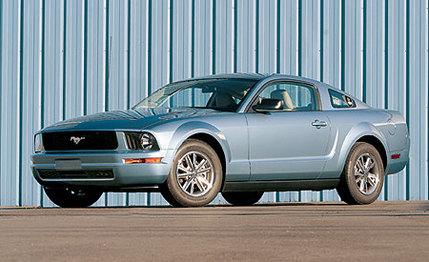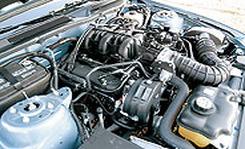
 Short Take Road Test
Short Take Road Test
Women like Mustangs. Something about this sporty coupe results in nearly 55 percent of V-6 Mustangs being driven by females. For some reason, women don't crave the tire-burning quality of the V-8, so instead they opt for improved fuel economy and a lower price. It's not surprising, then, that the macho brain trust here at C/D has shunned the V-6 model—the last time we wrote about one was more than 10 years ago.
But all that has changed with Ford's redesign of the Mustang for 2005. The lesser model now gets a larger V-6: the 4.0-liter SOHC plucked from truck duty in Explorer, Mountaineer, and Ranger models. It produces 210 horsepower and 240 pound-feet of torque, a gain of 17 horsepower and 15 pound-feet over last year's 3.8-liter unit. The engine upgrade may not seem monumental, but even more important, Ford now adds an extra gear with the optional five-speed automatic.
Shifting this five-speed into "D" involves grasping what looks like a scaled-down lever from a Hummer H2. Surprisingly, the Mustang's unit feels much more substantial than the H2's and settles into gear purposefully.
After shifting and a little brake-torque tango, the additional power and extra ratio add up to more straight-line performance than we expected: 0-to-60 mph arrives in 6.9 seconds, and the quarter-mile is over in 15.3 seconds at 91 mph. That performance would humiliate owners of the last V-6 Mustang we tested (a 145-hp manual back in May 1994), which scored an 8.3-second 0-to-60 time and a 16.5-second quarter-mile. Also, this puts the new V-6 auto just 0.6 second off the old automatic V-8's 0-to-60 time and only 0.2 second slower in the quarter. Besides the impressive numbers, we almost enjoyed not shifting for ourselves, instead marveling at the perfectly executed wide-open-throttle upshifts. But be sure to turn up the radio, because this engine sounds about as refined as a slightly muffled tractor.
Unfortunately, the good stuff stops there. To ensure the V-6 model wasn't too much of a performer, Ford fit it with low-end P215/65R-16 BFGoodrich Traction T/A tires, which provide explanations for an unimpressive 189-foot stop from 70 mph and a 0.79-g skidpad effort. Although the 11.5-inch front brakes on the V-6 model are 0.9 inch smaller than the V-8's, and the suspension is slightly softer, these tires account for most of the V-6's poorer perfomance versus the 10Best-winning GT model's 170-foot 70-to-0-mph braking distance and 0.89 g of lateral grip.


Ford also decided this would be a good time to install a fuel-economy gauge in the information screen that is, quite possibly, the least useful gauge on the market. Most people would expect a miles-per-gallon gauge to display precisely how many miles per gallon the vehicle is achieving, but the Mustang's doesn't have any numbers. There is a down arrow on the left side and an up arrow on the right, which apparently means down is bad fuel economy and up is good. Digital bars that fluctuate between the arrows essentially state the obvious: how far down on the throttle your foot is. When your foot is to the floor, the gauge indicates "bad" fuel economy and vice versa. This strikes us as either not enough information or an insult to the driver.
Such quibbles aside, the V-6 Mustang now starts at an attractive $19,410, just a few grand more than a comparably equipped Chevy Cobalt LS. Ours was a Premium model, which adds $585 to the sticker for a power driver's seat, an in-dash six-CD changer, and chrome spinners on the wheels. We also added the automatic, ABS and traction control, an interior upgrade kit, and a couple extra airbags to bring the checkout total to $22,890.
We find this entry-level Mustang to be a compelling package, with retro good looks, power aplenty, and a reasonable price. We still maintain complaints about steering that is too light and too fast, solid-rear-axle shudder, and difficult-to-read gauges—traits we initially discovered on the GT—but for about $5600 less, they become easier to accept.
Women may not care about the entry-level Mustang's upgraded performance, but-trust us, guys-the V-6 now has enough muscle to be a viable option for you, too.